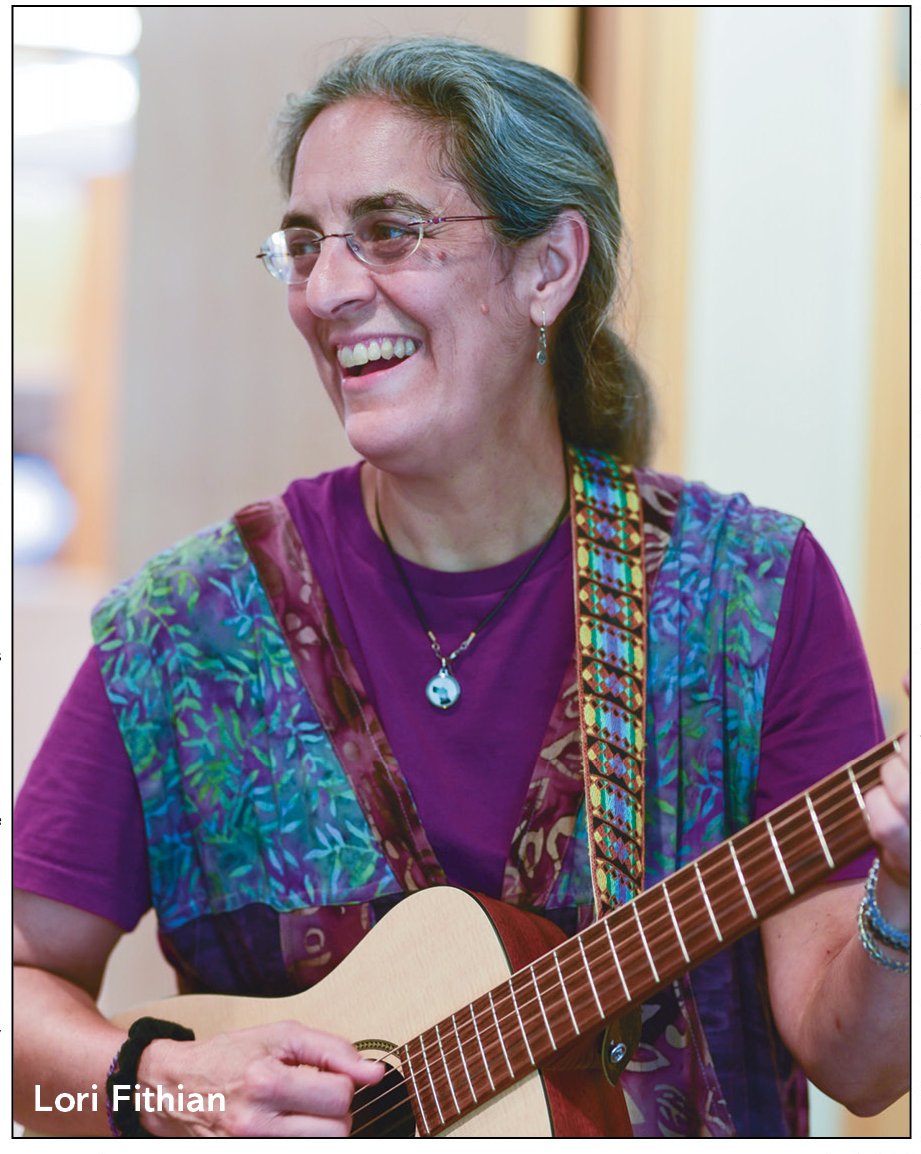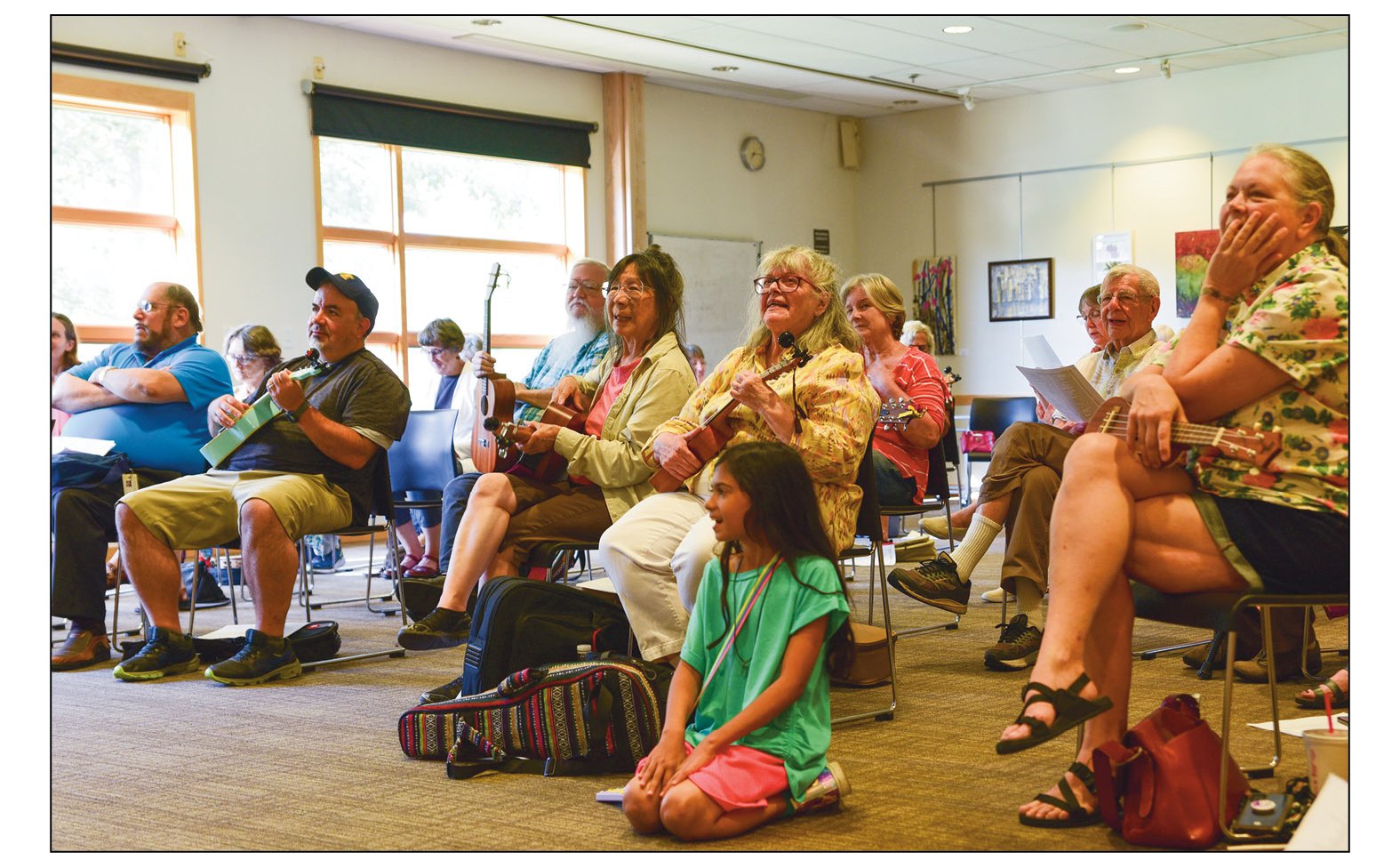By Sandor Slomovits • Photos by Hilary Nichols
A half hour before the six o’clock start time of the monthly Folk Song Jam Along, there were already about a half dozen people in the program room at the Westgate Branch of the Ann Arbor District Library. Song leaders Lori Fithian and Jean Chorazyczewski greeted early arrivals at the door and chatted with familiar regulars. There were about fifty chairs facing the large pull-down screen at the front of the long rectangular room. Fithian had set her Mac laptop, complete with purple case, on the lectern on one side of the screen, and Chorazyczewski’s Yamaha electric keyboard rested on its stand near the other side. Fithian’s brother, Eric Fithian, an excellent guitarist and bass player who has performed in a variety of bands around town for years, had plugged in his amplifier near Chorazyczewski’s keyboard and sat in the front row, noodling on his vintage Gibson electric guitar.
By six ‘o clock there were about twenty people seated throughout the room, some holding instruments—several guitars, a banjo, a baritone ukulele—while others were perusing the two-page song list that Fithian and Chorazyczewski had placed on every chair. There were 236 songs on the list, titled in alphabetical order, from the “Addams Family theme song” to “Zip a Dee Doo Dah,” with a number next to each.
Fithian projected the lyrics of “Come and Go with Me to That Land” on the screen, with the chords above the words, and set the rhythm and tempo on her guitar. Everyone joined in, plucking, strumming, and singing. Chorazyczewski played chords with her right hand and bass lines with her left. Eric Fithian added tasteful guitar fills, and Fithian called out each new word to “zip” into the successive verses of this traditional gospel blues “zipper song.” There’ll be” justice… freedom… singing… dancing… in that land where I’m bound.
Partway through the song, someone near the back of the room joined in with a tambourine. When the song was done, Fithian asked, “You guys know the drill, right? Call out a number, whatever song you want to do next.”
Chorazyczewski added, “We’re still just warming up, then we’ll introduce ourselves.”
Someone called out, “How about 119?”
Fithian tapped on her laptop, projected “Clementine” on the screen, and Chorazyczewski started the song’s waltz rhythm.
“In a cavern, in a canyon…” Everyone sang along, some on the melody, some adding harmonies, some giggling at the silly lyrics. When the song was done, a man in the front row said, “You missed a verse.”
“Is there another one?” Fithian asked.
“Yes,” the man replied.
“How does it go?” Fithian asked.
The man sang, How I missed her/ How I missed her/ How I missed my Clementine/’Til I kissed her little sister/Dreadful sorry Clementine.
After the laughter died down, Fithian asked, “What’s next?”
Jean Chorazyczewski and Lori Fithian have been leading interactive community music-making events for decades. They met in 2003 when Fithian was holding regular drumming sessions on the second floor of the Crazy Wisdom Bookstore. For years they’ve also hosted annual winter solstice holiday sing-alongs every December at the Unitarian Church. They were inspired to start the Folk Song Jam Alongs in 2012, after participating in a world-wide community sing called One Earth One Voice—Global Sing for Peace, also modeling the jams after a similar series in East Lansing where Sally Potter has been leading a monthly Community Sing for a long time. They began conducting the free monthly jams at the Unitarian Church.
“Fithian and I were helping plan things like family camp at the Unitarian Church,” said Chorazyczewski. “We always did some musical something or other there, at the women's retreat and that sort of thing.”
Fithian continued, “We were always about, how do we bring people together for fun? You don't have to be an expert singer. It doesn't matter. No rehearsals, no reading music, no pressure, just singing for fun.”
“When we started, we only had a short list of songs that we would do,” said Chorazyczewski. “But over all these years we've built up what we like to call our thing, which is over 300 songs, and growing.”
In 2019 they decided they wanted to be more centrally located and approached Katie Monkiewicz at the Ann Arbor District Library about holding the jams at the library. In October of 2019, Monkiewicz scheduled them for a few monthly sessions alternating between the Westgate Branch and Mallett’s Creek. The jams were very well attended and Fithian, Chorazyczewski, and everyone at the library was excited and decided to continue in 2020.
Then the pandemic hit. The libraries closed and the monthly sings stopped, the last one was in February 2020. Fithian and Chorazyczewski restarted the jams in October of 2022, and since then have been on the first Tuesday or Wednesday of every month, alternating between the Westgate Branch and Mallett’s Creek.
People continued to trickle in. A man with his young daughter said sheepishly as they made their way down the center aisle, “We went to Mallett’s Creek by mistake.” Eric Fithian’s wife, Mary arrived, carrying her guitar case, sat next to him, and added her strong voice to the group. Many of the chairs were filled by now and a couple of people stood in the back. The group ranged in age from a little girl about seven, to septuagenarians (and even possibly octogenarians!).
It was a middle aged woman’s birthday that night. Fithian asked if anyone knew a birthday song besides the traditional one. A woman stood and sang Happy Birthday, Happy Birthday, We Love You to the tune of the Merry Widow Waltz and we all applauded.
Someone called out number 154 and Fithian said, “Wish us luck on this one. Eric will cover the intro.” Eric Fithian started the iconic intro for “Here Comes the Sun” on his guitar and we were off. Some people scat sang along with the instrumental parts. We even managed to struggle through the tricky bridge part.
Next, someone said, “Number 308” and Fithian projected “Que Sera Sera” on the screen and Chorazyczewski started the tune on her keyboard. She played the bass lines with her left hand and conducted gracefully and enthusiastically with her right. She signaled the fermatas, the arrhythmic held notes, and the ending, and then said, “By the way, we like to schmaltz things up, so feel free. Every song deserves a big finish.”
Then, it was 380, Stevie Wonder’s “Isn’t She Lovely.” Chorazyczewski gave us the starting note because it’s a little tricky to pick it out of the starting chord, and we began. Eric Fithian expertly played the signature riff that follows every verse, and we all sang and swayed along. Of course, we skipped over Stevie’s brilliant harmonica solo, but the song is so wonderful that it worked just fine without it. Instead, we repeated the whole tune again, and when we finished, Eric Fithian got some well-deserved applause.
Fithian said, “What’s next? Don’t be shy. We don’t judge anybody.”
The term “Folk Song” in the Jam Alongs’ title encompasses a much wider range of styles and genres than is commonly considered folk. But, as Louis Armstrong famously said, "All music is folk music—I never heard no horse sing a song!" At the jams the main criterion is “Songs that are familiar enough that you can recognize them,” Chorazyczewski said. Fithian continued, “What's really fun is if we play a song that everybody knows, like say, “Hey Jude.” Everybody gets into that.”
The list Chorazyczewski and Fithian have compiled includes the theme songs of TV shows like the Beverly Hillbillies, and I Love Lucy, soul songs like “My Girl,” gospel songs “Keep Your Lamp Trimmed and Burning” and “Peace Like a River,” hymns, show tunes, Broadway beloveds, children’s songs, rock classics, country standards, bluegrass favorites, jazz ballads, songs in languages other than English like “Besame Mucho” and “Fere Jacques,” and songs that don’t fit neatly into any category, like Sibelius’ “Finlandia.”
Throughout the night the focus was firmly on the singers. You could hear Fithian, Chorazyczewski, and Eric Fithian’s instruments and voices, as well as those of the other pickers and strummers, but they never drowned out or overwhelmed the voices of the group. Early on Fithian asked, “Are the instruments too loud?” We all agreed they were fine. A woman called out, “I feel freer to sing when everything is loud!” We all laughed.
There is no admission fee for the jams, and Chorazyczewski and Fithian don’t get paid to lead them. They’re offering them as a service to the community and because they love to make music with groups of people. Their early childhood musical experiences have led logically to these community sings.
“My family was Polish and very musical,” said Chorazyczewski. “We always had some kind of music in the household. My sisters and my brother all played either piano or accordion. And I wanted to be like my older sister. So, she was my first teacher and that was a disaster, because, while she taught me, you know, it's harder to learn from a family member because they can kind of like smack you. ‘No, that's a wrong note!’. My sister, worked at The Music Center, which was in East Detroit, where I grew up, and she had a teacher whose name was Mrs. DeWolf. She was this very prim and proper woman. Beautiful camel skirt with a crisp collar, a beehive, and cat glasses. I started taking lessons from her. I played classical songs, but I was not classically trained. Instead, the best thing that woman did for me ws teach me all the scales, and all the chords, augmented, diminished seventh, minor five, whatever. She did me the best favor in teaching me piano that way. It helps me play by ear now. I took piano lessons for a couple of years, but not long because my parents couldn't afford it. So, I just kind of copied my sister. My love of music came really from my family because we listened to everything: everything ethnic, Italian, Greek, Herb Alpert, and Polish music of course, polkas. There always was that kind of influence.”
“We always had some funky little set of bongos and a Seven Up bottle going on my grandma's back porch,” said Fithian. “Just singalongs. I think my uncle may have had a baritone ukulele. Eric taught himself guitar; he was always playing, and we would sing, “You Are My Sunshine” and all those classic folk songs. We all had a rhythmic sensibility to bang out something or tap on the table. Then, in fifth grade we were supposed to pick an instrument and I said, ‘I want to play the trumpet.’ And Mrs. Sharky said, ‘How about the French horn?’ I said, ‘Okay,’ and that was the best thing.
I began my classical training on the French horn and went all the way through into college. I even played when I got braces after my senior year. I actually got in the symphony band of the University of Michigan. I was last chair, but I still got in. I played a little bit into college and then at some point, I think maybe I was at a music festival, there was a drum booth, and I banged a hand drum. Oh, that sounded cool. And because I had had my bongo experience, I could fool around. It opened a door into this whole world of drumming: African drum workshops, Brazilian drum workshops, Cuban, and just being influenced by every rhythmical anything.
Then I kind of got sick of going to drum workshops because they were all the same. Traditional African drummers would teach us really simple parts and then [while we did those parts] just improvise like crazy.”
Then, my friend Matt said, ‘Hey, Arthur Hall is doing a drum circle workshop.’
I said ‘Okay, that sounds fun.’
So, we went into the percussion room of the Guitar Center, and he was doing what I do now, which is fooling around with drums. I had a double bell in my pocket. So, I ding, dinging, ding, just messing around for two hours. And that was the beginning of my whole drum circle facilitation career.
Arthur came up to me and said, ‘What's your name?’
I'm like, ‘Am I in trouble? Was I doing a bad thing?’
He goes, ‘Let's tell Lori thank you, because she was gluing us together.’ He invited me to a facilitation workshop in Ohio. That's when I began my whole drum circle thing. I taught myself guitar and became a singer just to add more music to the drum circle stuff that we did.”
Chorazyczewski and Fithian set a very relaxed, welcoming atmosphere at the jams. “It's not joining the civic chorus and having to do a performance later. It's recreational music making. It's getting together for a jam. It's what humans have been doing forever. It's not possible to mess up because you're just fooling around with music. You're playing. If it's not fun, we're doing it wrong. If you're not smiling, but seriously trying to play a certain thing, forget it. That's not what it's about. I'll even say, ‘Okay, if the chord chart says C major seven nine, or whatever, just play the C part, don't worry about the rest of it. Jean will fill in the extra notes.’”
“It's really about taking a pause and singing these amazingly fun tunes,” Chorazyczewski added, “So that you forget your cares for an hour and a half, and you leave, like laughing and skipping.”
“When we introduce [the jams],” said Fithian, “I'll sometimes say, ‘Hey, also, if anybody has a special connection or reason that you picked a song, just shout out, I have a story.’ So sometimes there's a little bit of community sharing. It's just not enough time, the hour and a half goes by so quick.”





































































































































































































I recently went twice to see A Complete Unknown, the biopic about Bob Dylan’s early rise to stardom from 1961 until 1965 with Timothee Chalamet as Dylan. Both times the audience was mostly age fifty and up. I am eighty-five—two years older than Dylan. We are members of what is called, misleadingly, “The Silent Generation.” The postwar generation are Boomers, who are associated with the upheavals of the 1960s, but as Dylan puts it in his memoir, Chronicles, One, “I had very little in common with, and knew even less about, a generation that I was supposed to be the voice of.” The well-known movers of that era—Dylan, Warhol, Ginsberg, Baez, Beatles, Rolling Stones, and many others—are prewar or war babies.